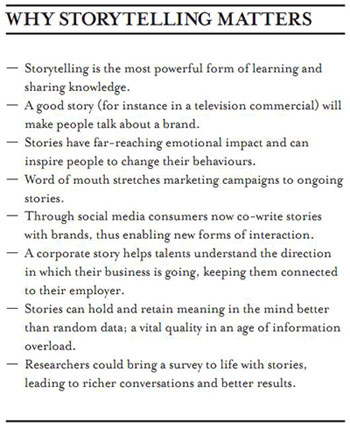Robert Heeg
Storytelling in business is becoming an important skill. Ever more effort goes into presentations and business stories. But how can organisations acquire storytelling expertise? And what does a good story look like, now that interactive media have altered this age-old form of communication for good?
We all do it every day without thinking. Storytelling is second nature to us. Yet, in most business segments, flat presentations, power point slides and dull stats still rule supreme. Awareness is growing though, that storytelling is essential for organisations that want to retain both clients and talents.
“Storytelling is the original and most powerful form of learning and sharing knowledge,” says Alison Esse, co-founder of The Storytellers, a pioneering UK-based consultancy that has developed a revolutionary approach to connecting people to strategy, vision, values and change on both a rational and emotional level.
The reasons behind this upsurge of tale-telling are manifold. Esse lists technology, globalisation, evolving consumer demand, as well as a distinct cultural change in business, and today’s employees’ need to understand the direction in which their business is going. All these drivers of change ask for a different, more narrative approach. “Stories about employees and customers – and their actions and behaviours – have far-reaching emotional impact and can inspire people to change their behaviours. Simply telling people to change won’t persuade them.”
Boring data
In market research, storytelling is also becoming a much-needed addition to the toolbox. At the recent ESOMAR congress in Athens, David Smith and Patrick Young of DVL Smith presented a paper on the power of storytelling. They argued that storytelling in business is going through a renaissance, with demand increasing in recent years. Indeed, anyone who attends too many congresses knows that the best presenters are skilled at getting people’s attention whilst at the same time bringing across their message. With anecdotes and humour, some speakers have almost become entertainers. David says that storytelling has become accepted in business “because neuroscience has confirmed what good presenters have known for ages: namely, that tapping into the audience’s emotions – not unfolding tedious blocks of boring data – is the way to engage and captivate an audience.”
The most entertaining CEOs, tech gurus and trend watchers know that their messages are being heard and remembered. Young says there is a catalogue of psychological evidence that highlights the power of stories to hold and retain meaning in the mind better than random data. “Stories provide a solution to the challenge of information overload. They have a unique ability to tie information together and bind it with emotion, context and, importantly, meaning. It is this last element which is perhaps most important; clients don’t want a body of research left at their door, they want the meaning of that research to be made clear to them.” Time-stressed clients, Young argues, are less prepared to sit through a ‘data dump’, but want clear thinking from the agency. “Researchers must put in the effort to distil the evidence for them.” Storytelling can also be of use in executing surveys. “Researchers could bring a study to life by starting the conversation with lines like ‘Tell me about a time when…,’” says Esse. “This is a great way of starting up dialogue and discussion. Richer conversations will happen as a result, and a more in-depth qualitative discussion, which will yield a more valuable response.”
Disconnect
Although awareness of all these benefits is growing, the adoption of storytelling skills by organisations and individuals is far from easy. Sometimes proposed changes are met with scepticism, other times by outright resistance. Esse knows why. “The very nature of storytelling tends to be viral, ethereal and intangible. This makes it difficult to implement in organisations with clear hierarchies and structured processes and systems.” Quite a number of factors inhibit storytelling, such as PowerPoint presentations, which are difficult to absorb and remember, says Esse. “We have become accustomed to them as a way to communicate, although their effectiveness is questionable.”
At DVL Smith, Young knows that there are still many organisations that see themselves as purveyors of data. “They believe that research is a product that should be delivered, as untainted as possible, to the client. To these individuals the idea of storytelling runs against this pure form. There is a disconnect in their mind between the hard data collected and this softer form of storytelling.” Stemming from this resistance to storytelling, Young adds, there is a feeling that storytelling takes too much time. A worry, by the way, he can’t quite take away. “It is true that the craft of storytelling demands that there be a new project stage inserted between data analysis and presentations; that of creating the story. We need to make time to turn our evidence into a story. And unfortunately some organisations may not be prepared to make this adjustment.” He also knows that the required skills aren’t always in house, and argues that more needs to be done to give individuals the tools and knowledge with which to tell a story. These can be very simple techniques, such as storyboarding, displayed thinking and applying themes. “These are many ways of breaking out of the straitjacket of the data and into a story.”
Lack of belief
In all fairness, some speakers can be hard acts to follow. But not making the effort at all is self-destructive, Smith warns. “Some mistakenly believe that storytelling is only for the likes of Steve Jobs launching the iPad, and not for someone presenting on a more prosaic topic. Lacking belief in the skills of the business storyteller means that many do not put in the hard yards of effort and practice to turn their chunks of data into a business-focused story. In short they sabotage and undercut their own presentation through a lack of belief and effort.”
It was at least promising for Smith and Young to see researchers respond to their presentation in Athens. “They wanted to know more about it, rather than challenge the idea”, Young is pleased to observe. “People have warmed to the idea of storytelling, of breaking the objective mould of standing and delivering the evidence. But they still need to know how to create a story. I think this is the next challenge we face as an industry.”
Never ending stories
In recent years storytelling in itself has evolved radically. The web in general, and social media in particular, have transformed the shape of stories from linear to non-linear, and from top-down narratives to participatory, ongoing interaction. “The biggest change has been in the continuity of the message. Social networking, 24-hour online access, and combined on- and off-line marketing campaigns have meant that stories have to be a continuation,” says Young. “From a purely research perspective, this idea of continuity is strong as well. We can no longer afford to see things in isolation, but rather we must contextualise and connect things together.”
Through Twitter, Facebook or corporate blogs, consumers now co-write ‘scripts’ with their favourite brands. In marketing, brands don’t just send messages anymore, but increasingly interact with consumers through, for instance, casual games or viral campaigns. All this interactivity brings opportunities as well as dangers, writes Forrester’s Josh Bernoff in his new book Empowered. The author of the business bestseller Groundswell argues that word of mouth is often misunderstood by marketers. Traditional marketing stories (read: campaigns) had a beginning and an end; in word of mouth, the campaigns are ongoing. For many marketers this concept is still hard to grasp. We asked Bernoff what all this means for the development of storytelling. He says: “Because of the nature of social media, the conversations tend to be disjointed, and don’t have nicely defined beginnings and endings. In some sense your customers are telling stories about you. And if you can create a story that resonates with them, that will help. If you do a television commercial that’s a story of your brand, and people like that, then they will talk about you. In any case, you must make sure that the story you tell about your brand, matches up to the brand’s behaviour.”
Engrained
The internet serves to expedite the ebb and flow of stories and can be used to great effect in demonstrating progress and inspiring others in a short timescale, says Esse. She does add that we nevertheless need to be aware of the cultural divides between different geographies. “So stories must be localised or selected carefully in order not to create a negative impact.” Esse warns that there needs to be a clear purpose behind stories. “Simply telling random stories that don’t illustrate particular strategic messages is pointless. So you need a master story or backbone on which to stick stories of achievement.”
The web may have changed the way we interact, but some traditions will never change, Smith says. “This is a generation who enjoy communicating in fast, snappier Twitter-style ways. But at the core of what youngsters are doing is telling stories – it continues to be the way we make sense of the world. So storytelling is not going away, it is engrained in our DNA.” And so, organisations had better get to grips with it. Although difficult, there are solutions available in the form of tools and courses. The Storytellers and DVL Smith appear in this article not only because they identify the problem, but also because they offer some of these solutions. Esse recommends the use of StoryMap; the corporate narrative which provides the necessary platform for great storytelling. “Some effective storytelling and/or communications training is part of the answer. We all tell stories every day of our lives, so given the right guidance, everyone can participate and be involved.” After all, says Smith, “the skills of the storyteller can be taught.” That’s good news for all those who have lost the plot.




3 comments
[…] https://archive.researchworld.com/tall-tales-the-strength-of-storytelling/ […]
Very well said, practically i have learned many thing from your post that in celebrations time we have to keep on working and with the help of ten easy tips improve the chances of the market research of agency.
[…] Tall Tales: The Strength of Storytelling – Robert Heeg, writing for Research World, tackles why storytelling matters. […]